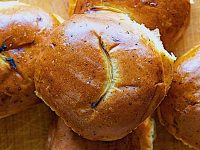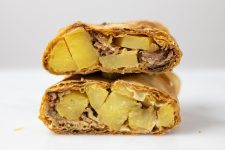Mákos Tészta: Hungarian Noodles With Poppy Seeds

One thing I can say for sure about visiting Hungary and taking up the cause of Hungarian cooking is that I’ve eaten more poppy seeds in the six months since we got back than I have in the previous six years put together. Hungarians put poppyseeds into almost everything—sweet and savory alike. On top of my list is this super simple, but extremely delicious, sweet noodle dish. Hungarians of all ages seem to love it. And having made it a fair few times now, I can see why.
To quote Gábor Bánfalvi, our very excellent Hungarian guide on our recent trip there, “Mákos tészta is an everyday Hungarian dish. Poppy seed, as you must have seen, is very important for our cuisine. Kids eat mákos tészta from nursery school to university cafeterias. It is more of a weekday dish, usually comes after a simple soup, like gulyás, or vegetable soup. As with any home-style dish there are dozens of versions—everyone’s mother, I can tell, has a bit of a different take. Basically though it’s hot egg noodles tossed with lots of poppy seeds and sugar. Generally the fat the noodles are tossed in is melted butter, but I’ve seen recipes that call for vegetable oil and others that laud the use of lard.”
Like so many of the foods I find most pleasing, mákos tészta is really quite simple to make. The sort of thing you could throw together after a long day’s work, or for a quick lunch, or I suppose, even breakfast. Just boil some good egg pasta until al dente. Toss with a decent bit of melted butter and lots of ground poppy seeds. (It’s easy to grind them in a coffee grinder at home. Poppy seed grinders pop up as frequently in Hungarian kitchens as cheese graters in Italy—i.e., pretty much everywhere. The standard ratio of poppy to sugar is one to one. I skipped the sugar and used vanilla syrup. I like the lilt of the vanilla and it’s easy to use. Or, you could also use vanilla sugar, one to one with the poppy seeds. To quote Gábor again, “The poppy seed is always ground and mixed with finely ground sugar. In our house my mom always ground the seeds together with crystal sugar in her small coffee grinder, just before lunch, so it was really fresh. Now instead of sugar I put honey on the pasta, which is really good.”
In terms of how much poppy seed to use, I’ll just say that the Hungarians use a LOT. So much so that really the dish looks like it’s been dressed in some sort of pale blue-black sweet poppy seed “pesto.” If you keep the sugar/syrup levels low, you can actually eat it for a main course. I’ve doctored it up a couple times with a bit ricotta cheese and/or toasted walnuts. In any case it’s basically an uncooked noodle kugel.
Speaking of walnuts, there’s a comparable Hungarian dish that calls for ground walnuts to be used in place of the poppy seeds. You can also do it with walnut oil instead of butter. Or, in the spirit of lemon poppy seed cake, you can use the lemon olive oil we get from Italy instead of the butter—that’s also quite delicious!
Going back to Gábor: “My kids love mákos tészta and it is usually the first thing they ask for when they visit their Hungarian grandma. They could eat it everyday. It is a simple dish, but with freshly ground poppy seeds, honey and homemade pasta you can bring it to a different level.” I can see why they love it. Mákos tészta is sweet, warm, comforting and super delicious!




Zingerman’s Art for Sale